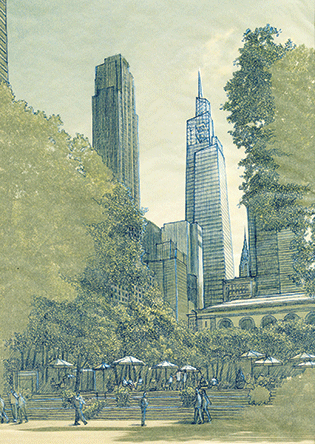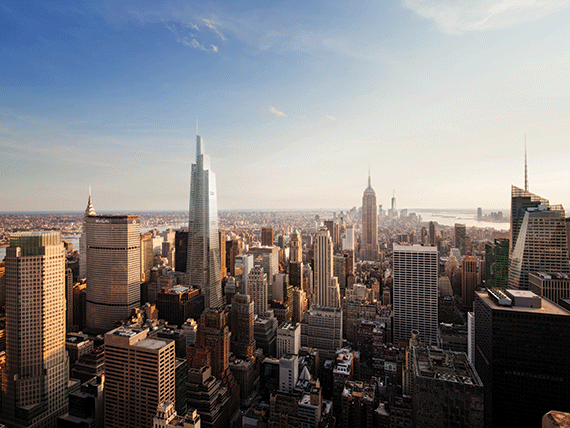One Vanderbilt, which will soon break ground on one of the key corners of East 42nd Street, is certain to alter the area in profound ways.
From river to river, 42nd Street is, of course, one of the iconic thoroughfares of Manhattan — a hive of constant and frantic life. But its character is hardly continuous along its two miles.
For more than a half century, the stretch from Fifth Avenue to about Second Avenue has been a fairly uninspiring stretch of office buildings. Many of these buildings, dating to the earlier part of the 20th century, are of impressive size but of no great architectural distinction. Then there are the Art Deco palaces of the 1920s and ’30s, like the Chrysler Building and the former Daily News Building, that also line the stretch, and post-war office towers such as the Socony-Mobil Building.
More recently, 42nd Street has seen additions like Skidmore, Owings & Merrill’s 300 Madison Avenue, in 2003, and Kohn Pedersen Fox’s 505 Fifth Avenue, two years later.
Although those last two buildings are quite tall, they have hardly altered the general spirit of the place.

A. Eugene Kohn
But the new building that is set to rise on the corner of Vanderbilt Avenue and 42nd Street, a 64-story, 1.7-million-square-foot office tower being developed by SL Green Realty and designed by Kohn Pedersen Fox, will represent a more fundamental change than anything this part of Manhattan has seen since the construction of the Chrysler Building. In fact, it will be the first tower in Midtown East to exceed that iconic building in height.
The new building — whose anchor tenant, TD Bank, will occupy 200,000 square feet of office space — promises to be one of the tallest in the city and the world. In exchange for approval from the city to rise 1,500 feet, SL Green will pay for $220 million in public infrastructure improvements in and around Grand Central Station.
The tower, which is scheduled for completion in 2020, will likely herald a new age of supertall buildings along Vanderbilt Avenue. In addition to greenlighting One Vanderbilt, the City Council also approved the rezoning of the Vanderbilt Corridor, a five-block stretch from 42nd to 47th streets. The change should be similar in certain respects to the arrival of those enormous residential structures on 57th Street along Billionaires’ Row.
For the most part, friends and foes of the project have been discussing this new project in terms of its effect on Grand Central Station. But the far more radical change will occur on Madison Avenue and on the entire block between Madison and Vanderbilt. For now, this short block is dominated by somewhat drab and relatively low-lying pre-war buildings done in a fairly traditional and classical style. Despite all of the tall Modernist buildings that surround them, these are the sorts of buildings that define this portion of Madison Avenue and many of the surrounding side streets. But One Vanderbilt Avenue will soon change that. Soon the solid and consolingly opaque pre-war structures will melt away, to be replaced by a single massive structure, defined by a sheer curtain wall, which, at street level, will throw open the entire area. That openness will no doubt create a complex interplay between the street activity and the building’s massive lobby, whose double-height space extends along the entire block. The renderings shows a tangle of sloping cantilevered spaces that interact and interlock in highly unusual ways.
In addition, because of the intricate series of tilted and Deconstructivist recessions and cantilevers on One Vanderbilt as well as a row of string-like pylons that appear to be perilously insufficient to the task of upholding the entire weight of the building, the northwest corner of Vanderbilt should suddenly feel as if air and daylight are flooding onto an avenue that hasn’t seen either in almost a century.
Those pylons, by the way, succeed, however improbably, in suggesting a pleasing visual rhyme with the paired Doric columns on the façade of Grand Central Station, which sits directly to its east. As such, the new building may not seem to be nearly as obnoxious an intrusion in the landscape as Walter Gropius’s nearby 200 Park Avenue, now known as the MetLife Building.

A sketch of One Vanderbilt
The bulk of One Vanderbilt rises from this base as an irregular glass curtain wall — constructed out of three or more interconnected masses — that tapers toward the summit. Then, at the very top, the building fractures abruptly into a complicated game of smaller pavilions, which are crowned by a small (but punchy) antenna that adds an additional 100 feet to the building’s height.
In addition to the curtain wall, the most marked features of the façade are the strong, thin coursing lines, ivory white in the renderings, that separate the floors.
How good are the results, in terms of the architecture? The design of the current project does not feel as striking or impressive as one could want. Whatever the ultimate worth of its fractured façade, according to any eternal canon of beauty, the days are long past when this Deconstructivist idiom felt especially fresh or innovative.
Indeed, 390 Madison, only a few blocks north and also designed by Kohn Pedersen Fox — a firm whose works include buildings like 10 and 30 Hudson Yards and One Jackson Square in New York as well as international towers such as the Shanghai World Financial Center — has much the same entranceway. One Vanderbilt also recalls the Bank of America Building at One Bryant Park, two blocks to the west, which was conceived nearly 10 years ago.
Other than its prodigious height, this newest project fails to stand out, as so often is the case with recent New York architecture. A rare exception is 432 Park Avenue. In that building, Rafael Viñoly pursued the apparent monotony of perfectly square modules with such manic persistence that he broke through to real interest and beauty. One thing that must be said about Kohn Pedersen Fox, however, is that they not only design but also oversee the construction of some of the best-built structures in the city. This means that, even if a design is not entirely prepossessing in and of itself, the quality of the tower may very well attain its own kind of beauty.
